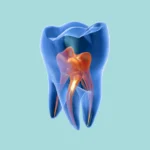Let’s be completely honest: preparing anterior teeth is truly an art form, requiring immense sensitivity and precision. Most of us meticulously focus on creating a clear finish line and, crucially, avoiding damage to the adjacent tooth. Yet, there’s a quiet mistake, one many of us inadvertently fall into, and it’s a primary reason why anterior restorations fail, both aesthetically and functionally: under-reduction, or simply put, “not removing enough tooth structure.”
Many of us are understandably hesitant to reduce too much, aiming to preserve tooth tissue – which is a perfectly valid intention. However, this excessive caution can often lead us to perform an inadequate preparation, and the outcome? A nightmare for you, the lab, and ultimately, the patient.
In this article, we’re going to thoroughly explain precisely what happens when you underestimate under-reduction. We’ll show you how this seemingly minor error can trigger a chain of unfortunate events, culminating in a crown that looks terrible, breaks easily, or even causes problems with the temporomandibular joint (TMJ).
1. The Facial Surface: Where Aesthetics Become the Victim
Picture this scenario with me: You’ve finished preparing an anterior central incisor and sent the impression to the lab. The lab technician receives it and finds themselves facing two equally unappealing options:
Scenario 1: The Technician Sacrifices Aesthetics for Strength
If your technician is highly skilled and aiming to create a crown with proper thickness for durability, but you haven’t provided sufficient space, they’ll have no choice but to make the crown over-contoured.
The Result? A crown that looks “bulky,” almost “barrel-shaped,” often opaque to mask the underlying tooth color, and drastically different from the adjacent natural tooth. In short, a disastrous unaesthetic outcome. What’s more, this often creates an overhanging margin near the gingiva, which collects food debris and calculus, leading to chronic gingival problems.
Scenario 2: The Technician Sacrifices Strength for Aesthetics
Alternatively, if the technician tries to “make do” with your limited preparation space to achieve a decent aesthetic, they’ll be forced to make the porcelain layer incredibly thin.
The Result? An extremely weak crown that might fracture even during the try-in stage. And if it does survive, its color will appear excessively grayish or exhibit low value, transparently revealing the dark underlying tooth structure. So, in either case, both aesthetics and strength are compromised.
The Takeaway: Inadequate preparation on the facial surface essentially forces the technician into a lose-lose situation: either a visually displeasing crown or a structurally weak one. Either way, the restoration is ultimately a failure (1).
2. The Palatal Surface: When the Bite Goes Awry
Many of us tend to focus intently on the facial aspect while neglecting the palatal surface, even though it’s no less critical. Under-reduction in this area typically leads to two distinct problems as well:
The Thin, Fracturing Crown:
If the technician makes the crown thin to respect the occlusion, it will fracture very easily. Why? Because the entire force of anterior occlusion is concentrated precisely in this region.
The Over-Contoured, Bite-Altering Crown:
If the technician opts for a respectable crown thickness, it will inevitably end up over-contoured towards the lingual/palatal side. Here, the issue isn’t merely that it will bother the patient’s tongue. The far greater problem lies in its profound impact on the occlusion. This over-contoured crown will create a premature contact point, causing the patient’s lower anterior teeth to hit it first. This seemingly minor issue opens the door to a much larger catastrophe.
3. The TMJ: The Unexpected Final Victim
What on earth does preparing a single tooth have to do with the temporomandibular joint? The connection, surprisingly, is very direct. When you create an over-contoured crown on the palatal aspect, you significantly disrupt something crucial called the Anterior Guidance.
So, What Exactly Happens?
-
When the patient attempts to fully occlude their teeth, they immediately encounter this high crown.
-
To avoid this premature contact, the patient’s brain instinctively signals the mandible to retrude (move backward) slightly, in an effort to find a more comfortable biting position.
-
As the mandible retrudes, the condyle (the part of the jaw bone that articulates with the skull) is forced into an unnatural position within its fossa.
-
Over time, the jaw muscles and the joint itself try to adapt to this new, incorrect position. This maladaptation can lead to a cascade of problems: muscle pain (myalgia), joint clicking, and eventually, genuine pain and significant issues within the temporomandibular joint (TMJ) (2).
The Bottom Line: Inadequate palatal preparation could very well be the root cause of a patient’s complaint, months later, that “my bite feels off” or “I feel pain near my ear.”
So, What’s the Right Preparation? (A Quick Guide)
To completely avoid all these potential disasters, the correct preparation must provide adequate space for the lab. These figures are your essential guide:
-
Facial Surface: Requires a precise two-plane reduction. Aim for 1.2 to 1.5 mm of reduction.
-
Incisal Edge: Reduce by 1.5 to 2.0 mm.
-
Palatal/Lingual Surface: You absolutely must provide sufficient clearance to allow the mandible to move freely without any premature contact.
Your Most Important Tool: Always use a putty index or a reduction guide. This allows you to visually confirm that you’ve achieved adequate reduction in all dimensions before taking the impression. Never rely solely on estimation (3).
The Final Takeaway
Under-reduction isn’t just a minor oversight; it’s a fundamental problem that can undermine the entire restoration. The extra minute you spend meticulously ensuring adequate reduction will genuinely save you hours of frustrating problems and failed attempts down the line.
Accurate tooth preparation isn’t a luxury; it’s the sole guarantee that you can provide your patient with an ideal treatment outcome—both aesthetically and functionally—one that will stand the test of time for many years, completely free from issues.




















